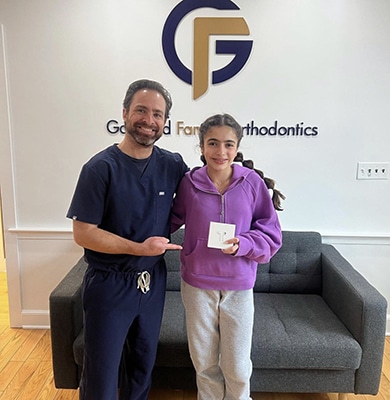Regarding our children’s health and well-being, especially, we as parents want nothing but the best for them. Their oral health, particularly the alignment and growth of their teeth and jaw, is an element of their general health that should not be disregarded. We will examine the importance of early orthodontic care and treatment for kids, highlighting the priceless advice from a skilled orthodontist in Morristown. Here is when an orthodontist’s knowledge is useful. Goldkind Family Orthodontics is a reputable name in orthodontic care in Morristown.
When Should Children Start Orthodontic Care?

According to the American Association of Orthodontists, it is recommended that children undergo their first orthodontic screening by the age of seven. This preliminary assessment can help detect and address any dental problems at an early stage.
By having an early orthodontic evaluation around the age of seven, parents can ensure that any potential dental issues are identified and addressed promptly. This proactive approach allows orthodontists to intervene at the right time, guiding proper jaw growth, tooth eruption, and alignment.
However, it is crucial to understand that every child is unique, and the need for orthodontic care may vary. Factors such as dental development, skeletal growth, and the severity of orthodontic issues are considered when determining the appropriate timing for treatment.
What Does Orthodontic Care for Children Involve?
Orthodontic care for children involves a range of treatments and procedures designed to correct dental issues and promote optimal oral health. The specific treatment plan will vary depending on the child’s needs, as determined by the orthodontist. Here, we will explore some common components of orthodontic care for children.
Step 1: Comprehensive evaluation
The first step in orthodontic care for children is a comprehensive evaluation by an orthodontist. This evaluation thoroughly examines the child’s teeth, jaws, and oral health. The orthodontist will assess the alignment of the teeth, jaw relationships, and any current or potential orthodontic issues. This evaluation serves as the foundation for developing a personalized treatment plan.
Step 2: Diagnostic imaging
Orthodontists may employ diagnostic imaging techniques to gain a more comprehensive understanding of the child’s dental structures. X-rays, photographs, and 3D imaging can provide detailed information about the positioning of the teeth, jaw development, and skeletal structures. These images assist in accurate diagnosis and treatment planning.
Step 3: Orthodontic appliances
Orthodontic appliances are crucial in correcting dental issues and guiding proper dental development in children. Some commonly used appliances include:
- Braces: Traditional braces consist of metal brackets bonded to the teeth, connected by archwires. These braces apply gentle pressure to move the teeth into their proper positions gradually. Braces can address many orthodontic concerns, such as overcrowding, misalignment, and bite issues.
- Clear aligners: Clear aligners, such as Invisalign, are a popular alternative to traditional braces. These removable, transparent trays gradually shift the teeth into alignment. Clear aligners are convenient, comfortable, and less noticeable, making them a preferred option for some children.
- Space maintainers: In cases where a child loses a primary (baby) tooth prematurely, space maintainers can be used to preserve the gap and prevent neighboring teeth from shifting. These appliances ensure enough space for the permanent tooth to erupt correctly.
Step 4: Regular adjustments and monitoring
Orthodontic care for children typically involves regular appointments for adjustments and monitoring. During these visits, the orthodontist will make necessary modifications to braces or aligners, ensuring the treatment progresses as planned. These appointments also allow the orthodontist to monitor the child’s dental progress, address any concerns, and provide guidance on oral hygiene practices and dietary considerations.
Step 5: Retention phase
After the active orthodontic treatment is complete, a retention phase follows. Retainers, either removable or fixed, are used to maintain the corrected position of the teeth. This phase is crucial to prevent relapse and ensure the long-term stability of the treatment outcomes.
It’s important to note that each child’s orthodontic treatment plan is unique and tailored to their needs. The duration of treatment may vary depending on the complexity of the orthodontic issues and the child’s response to the treatment.
The Benefits of Early Orthodontic Treatment

- Prevention of invasive treatments: Early intervention can prevent the need for more complex and invasive procedures in the future, such as extractions or surgery.
- Improved appearance and self-confidence: Correcting orthodontic issues early can enhance dental alignment, leading to a more attractive smile and increased self-esteem.
- Enhanced oral function: Early treatment addresses functional concerns, improving chewing, speaking, and oral hygiene practices.
- Positive impact on oral and overall health: Orthodontic care promotes better oral health, reducing the risk of dental issues and improving jaw alignment, potentially alleviating headaches and facial pain.
Caring for Your Child’s Teeth During Orthodontic Treatment
When receiving orthodontic treatment, it’s of utmost importance to uphold a strict oral hygiene regimen. This entails consistently brushing and flossing, in addition to refraining from consuming specific types of food that could potentially damage the orthodontic appliances or result in tooth decay.
Advise your child to avoid hard, sticky, or chewy foods that can damage the appliances or lead to tooth decay. Regular dental check-ups and following the orthodontist’s instructions are essential for monitoring progress and ensuring proper care. By prioritizing oral hygiene and making mindful choices, you can support your child’s oral health during orthodontic treatment.
Schedule Your Child’s Orthodontic Evaluation Today

Early orthodontic care and treatment are essential for your child’s dental health. Goldkind Family Orthodontics, an orthodontist in Morristown, offers knowledge, experience, and a dedication to giving your child the best care possible. Early orthodontic intervention can help to promote proper oral growth, avoid issues, and increase your child’s self-confidence. Don’t wait for issues to escalate in complexity. Schedule a consultation with a Morristown orthodontist right away to give your kid the gift of a lifelong, gorgeous, healthy smile.
